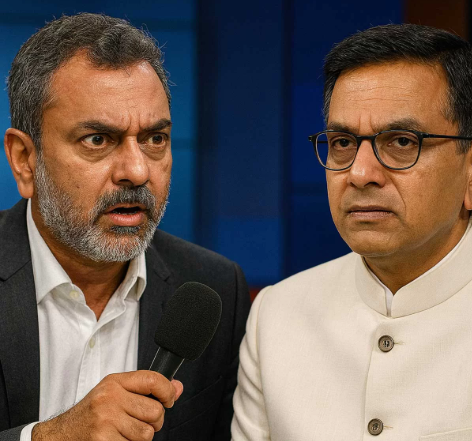– Abdul Bari Masoud
When former Chief Justice of India D.Y. Chandrachud sat across from journalist Sreenivasan Jain in a Newslaundry interview late last month, he may not have anticipated the storm that would follow. Asked to reflect on the Supreme Court’s 2019 Ayodhya verdict, Chandrachud described it as “a delicate balance of faith and law.”
Then came the line that has refused to fade: “The very erection of the Babri Masjid was the fundamental act of desecration.”
The remark set off a wave of outrage. Critics accused him of parroting the ideological narrative of RSS, while defenders insisted his words were taken out of context. For many, however, this was not a mere slip of language; it was a revelation of what the Ayodhya judgment truly represented: a quiet surrender of constitutional reason to majoritarian faith.
The interview has stripped away the veneer of neutrality, exposing his deeper ideological leanings. Senior Advocate of Supreme Court, Rajeev Dhavan’s words come true who had said in an interview to Radiance three years back that Chandrachud toed the government and Sangh Parivar’s line in several judgments.
A Storm Rekindled
In the interview, Chandrachud was pressed on why the court, after acknowledging that the demolition of Babri Masjid was illegal, still handed over the entire disputed land to Hindu claimants. Chandrachud argued that the Muslim parties had “failed to establish continuous and uncontested possession,” and that the mosque’s very construction in the 16th century had been an act of desecration.
Jain countered that the court’s own judgment had noted no archaeological evidence proving the mosque was built over a demolished temple. “The underlying structure could have fallen for any number of reasons,” Jain said.”
But the former CJI said the “fundamental desecration” had occurred in 1526, not 1992. It was a stunning moment – a former head of the judiciary appearing to validate the theological argument that has long powered the Hindutva movement.
Clarification and Fallout
Facing fierce backlash, Chandrachud later sought to clarify his position at the India Today Conclave in Mumbai. He insisted his comments were being “selectively circulated” and stripped of context.
“What is happening on social media,” he said, “is that people lift one part of the answer and combine it with another part, completely removing the context.”
Chandrachud stressed that the 2019 Ayodhya verdict was based on “evidence and legal reasoning, not faith,” adding that few critics had actually read the 1,045-page judgment or the 30,000-page case record.
Yet his defence did little to quell the uproar. For a generation that had viewed him as a torchbearer of constitutional liberalism, his comments seemed to mark a philosophical retreat – from the language of rights to the logic of belief.
From Liberal Hope to Institutional Conformist
When Chandrachud was elevated to the SC in 2016, expectations ran high. The son of Y.V. Chandrachud, India’s longest-serving Chief Justice, he arrived with a Harvard doctorate, a stellar reputation from Bombay and Allahabad High Courts, and an aura of intellectual independence.
In his early years on the SC bench, he appeared every bit the progressive jurist India’s liberal establishment had hoped for. His landmark opinions in Puttaswamy (privacy), Joseph Shine (adultery), and Navtej Johar (decriminalising homosexuality) positioned him as the conscience of a modern, rights-based judiciary.
With his dissent in the Aadhaar case, calling the passage of the Aadhaar Act as a Money Bill “a fraud on the Constitution,” legal observers saw in him the makings of a fearless CJI who could stand up to executive overreach.
But when that moment came in 2022, something changed.
‘Selective Courage’ as Chief Justice
During his tenure as Chief Justice (2022-2024), Chandrachud’s court delivered a mix of progressive and cautious verdicts – a pattern that came to define him as a jurist of “selective courage.” Under his leadership, the court struck down the BJP’s opaque electoral bonds scheme, but refused to probe the alleged quid pro quo that allowed the ruling party to benefit disproportionately from it.
He upheld women’s reproductive rights and extended equality to women officers in the armed forces but declined to intervene decisively in cases involving political dissent, leaving activists like Umar Khalid and Sharjeel Imam behind bars under UAPA.
Each episode reinforced a paradox: Chandrachud, the eloquent defender of liberty in public lectures, appeared a cautious institutionalist when it mattered most.
‘Performative Justice’ and Critique of Power
Former Supreme Court Bar Association president Dushyant Dave remarked that Justice Chandrachud “spoke eloquently outside the court, but failed to match those words with action inside it.” Justice Madan Lokur, who once shared the bench with him, voiced a similar sense of disillusionment.
His tenure, many critics argue, poses a larger and more uncomfortable question – not merely about one judge’s choices, but about the evolving character of India’s judiciary itself in an age when power demands deference and silence often replaces dissent.
Journalist Saurav Das, writing in The Caravan, captured this contradiction sharply, describing Chandrachud as a figure of “performative justice” – a judge whose moral vocabulary outpaced his judicial courage.
That view is shared by many within the legal fraternity, including Dushyant Dave. In a wide-ranging interview with The Wire, Dave accused the former CJI of being “more concerned with optics than outcomes.”
Dave also accused Chandrachud of manipulating the bench roster to favour the government: “He withdrew a case from Justice Sanjay Kaul’s bench that was questioning the government’s delay in implementing collegium recommendations. That was unprecedented.”
Faith, Power, and Optics of Proximity
The controversies surrounding Chandrachud extend beyond his judgments to his public conduct. During his tenure as CJI, he invited Prime Minister Narendra Modi to his residence to perform a Ganesh aarti – a gesture he later defended as a “mark of mutual respect between high constitutional functionaries.”
But for many, the symbolism was troubling. K. Sudha, law professor and Human Rights Forum member, described it as “a dangerous erosion of constitutional propriety.”
“From performing a Ganesh puja with the Prime Minister to saying he sought God’s help in deciding Ayodhya, everything he said and did was a contempt of the Constitution,” Sudha said.
Gyanvapi and Article 370 Questions
In the same interview, Chandrachud also defended the SC’s decision to permit a survey of Gyanvapi Masjid, despite the 1991 law protecting the character of religious structures. He argued that it was “undisputed” that prayers had been held for centuries in the mosque’s cellar – a claim the mosque trust has consistently refuted in public and in court.
He also defended the Article 370 judgment, insisting that the court had “acted within constitutional parameters.” But the verdict’s effect – endorsing the government’s unilateral abrogation of Jammu and Kashmir’s special status – was widely seen as a judicial nod to executive dominance.
Between Dissent and Deference
Chandrachud’s judgments on abortion rights, minority education, and passive euthanasia will endure as milestones in expanding the meaning of personal liberty. But his silences are equally telling. The SC under his leadership didn’t hear challenges to the CAA. It avoided ruling on anti-conversion and hijab laws. And in India’s charged political climate, delay itself became a form of judgment.
Justice Madan Lokur, his former colleague, perhaps captured the mood best that “Chandrachud spoke like a liberal but acted like an institutionalist. Perhaps that’s what survival demands in today’s India.”




